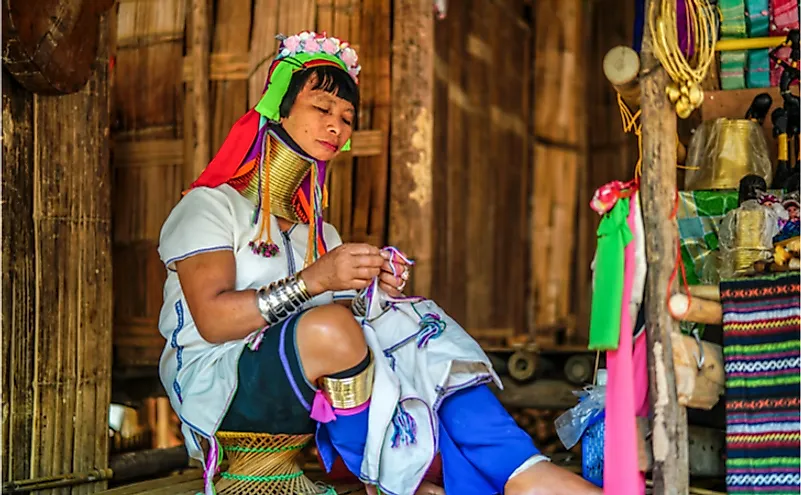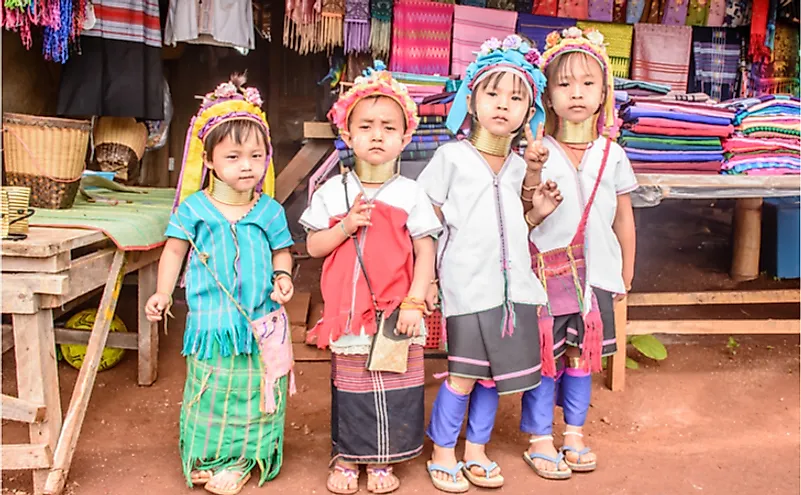10 Interesting Facts About The Kayan People Of Myanmar

The Kayan people of Myanmar are a subgroup of the Karenni people ( Red Karen). The population of the Kayan is estimated at 130,000, of whom more than half live in Myanmar. They are found in Karenni State around Loikow and Demawso and southern Shan State. The Kayan inhabit three villages in Mae Hong Son province of Thailand; Huay Pu Keng, Huai Seau Tao, and Karenni refugee camp. These are some interesting facts about the Kayan.
There Are Several Sub-tribes Of The Kayan People
The Kayan consists of several groups, including Kayan Lahwi (Padaung), Kayan Ka Khaung, Kayan Kakhi, Kayan Ka Ngan, Kayan Lahta, Kayan Gebar, and the Bwe people. The Padaung are popularly known for their brass neck coil. The Kayan people of northern Thailand are closely linked to Padaung but prefer being called Kayan.
Kayan People Have A Refugee Status
In the 1980s and 90s, many fled the civil war in Myanmar and sought refuge in Thailand, where they integrated with the local Thai people and are still living in the country. Although some have assimilated into the local Thai population, a majority continue to live in abject poverty in refugee camps along the border of Thailand and Myanmar.
Kayan Women Wear Brass Neck Ring
The most distinctive culture of the Kayan people is the brass neck ring worn by women. Although all tribes wear the ornament, it is popularly associated with the Kayan Lahwi sub-tribe. Girls begin to wear the ring at the age of five and are replaced by larger ones as they age.
Once In, No Out
Once the coil is worn, it is rarely removed since uncoiling it is a lengthy procedure. Since 2006, younger women have shunned the ornament to pursue education and protest the restrictions imposed by their culture. In the past, the Kayan believed that removing the coil lead to a broken neck and death by suffocation The government discourages women from wearing the ornament in a bid to change the retrogressive culture.
Induced Long Necks Of Kayan Women
The coil weakens the neck muscles and often bruise and discolor the collarbone. It appears to lengthen the neck by deforming the clavicle. It is the reason why Kayan women have earned the moniker “ long-necked women.” Kayan women barely feel the weight of the brass since the ring feels like part of the body after several years of wear.
Unique Marriage Traditions
Traditionally, the Kayan people engaged in a pre-planned marriage where the parents determined the marriage partners, but the culture has faded away, and the younger generations are allowed to select their partners. Unlike other societies, marriage can only occur between genetically related partners, and a first cousin is the most preferred partner. However, it is a taboo to marry outside your generation. It is forbidden for conflicting clans or in-laws to marry.
Lazier Men Pay More Dowry
After a young man identifies a suitable partner, his parents approach the parents of the girl with a gift, and the couple is said to be engaged if both parties agree. The man’s family provides the dowry, and the daughter-in-law moves in with her husband on marriage. Men pay more dowry if they move to the woman’s house as a punishment for not working hard enough to provide for his spouse.
Descendants Of Male Human And Female Dragon
Kan Khwan is the traditional religion of the Kayan people; it was introduced by the ancient immigrants from Mongolia and is still practiced by a few people. The religion works on the belief that the Kayan are descendants of a male human and a female dragon. The Kay Htein Bo religious festival, which is held for three days between late April, and early May, commemorates the day the creator gave life to the world. It is also a time when all Kayan communities come together to pray for rain, blessings, and forgiveness.
Modern Religion Dominates Today
Although many participate in traditional festivals, most have adopted modern religions, especially the Roman Catholic, as a consequence of the 19th-century Italian missionaries. Some members are Buddhist and Baptist. The overseas Kayan population has integrated with their host religions and rarely engage in traditional religious activities and festivals.
A Dying Culture Needs Revival?

The Kayan are slowly but surely losing their tradition as they assimilate into other communities. Although their numbers have a role to play in this, punitive culture is to blame. The younger generation seeks to integrate more with the outside world by shunning the norms. Women who continue wearing the coils do so for the economic reason for attracting tourists rather than cultural.











